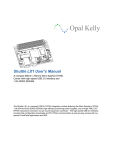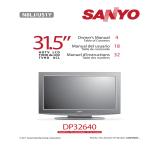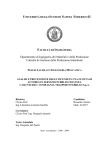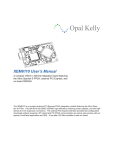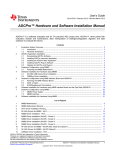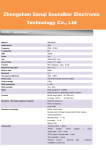Download EVB100x User`s Manual
Transcript
Opal Kelly EVB100x User’s Manual A 5-Mpixel image capture board for the XEM6010, XEM6110, XEM3050, XEM3010, and Shuttle LX1 FPGA integration modules The EVB1005 is an image capture module for use with the Opal Kelly XEM6010, XEM6110, XEM3050, and XEM3010 FPGA modules. The EVB1006 is an equivalent capture module for the Shuttle LX1 (XEM6006) or other FMC carrier. Both modules include a Micron MT9P031I12STC 5 mega-pixel color image sensor and necessary power supply circuitry. Designed as evaluation boards for Opal Kelly integration modules, the modules provide an excellent platform for getting accustomed to the FrontPanel SDK. Software, documentation, samples, and related materials are Copyright © 2011-2012 Opal Kelly Incorporated. Opal Kelly Incorporated Portland, Oregon http://www.opalkelly.com All rights reserved. Unauthorized duplication, in whole or part, of this document by any means except for brief excerpts in published reviews is prohibited without the express written permission of Opal Kelly Incorporated. Opal Kelly, the Opal Kelly Logo, and FrontPanel are trademarks of Opal Kelly Incorporated. Linux is a registered trademark of Linus Torvalds. Microsoft and Windows are both registered trademarks of Microsoft Corporation. All other trademarks referenced herein are the property of their respective owners and no trademark rights to the same are claimed. Revision History: Date Description 20120101 Initial release. 20121112 Fix EVB1006 Schematic with production version. Contents Introducing the EVB100x. . . . . . . . . . . . . . . . . . . . . . . . 5 Image Sensor. . . . . . . . . . . . . . . . . . . . . . . . . . . . . . . . . . . . . 5 Mechanical Information. . . . . . . . . . . . . . . . . . . . . . . . . . . . . . 5 Lens and Lens Holder (included with EVB100x) . . . . . . . 6 Functional Block Diagram. . . . . . . . . . . . . . . . . . . . . . . . . . . . 6 Power Supply. . . . . . . . . . . . . . . . . . . . . . . . . . . . . . . . . . . . . 6 XEM6110 . . . . . . . . . . . . . . . . . . . . . . . . . . . . . . . . . . . . . 6 XEM6010, XEM3050, and XEM3010. . . . . . . . . . . . . . . . 6 XEM6006. . . . . . . . . . . . . . . . . . . . . . . . . . . . . . . . . . . . . 7 JTAG Chain. . . . . . . . . . . . . . . . . . . . . . . . . . . . . . . . . . . . . . . 7 XEM6010 and XEM6110 . . . . . . . . . . . . . . . . . . . . . . . . . 7 XEM3010 and XEM3050. . . . . . . . . . . . . . . . . . . . . . . . . 7 Electrical Interfaces (EVB1005). . . . . . . . . . . . . . . . . . . . . . . 7 I2C Interface. . . . . . . . . . . . . . . . . . . . . . . . . . . . . . . . . . . 7 Pixel Interface. . . . . . . . . . . . . . . . . . . . . . . . . . . . . . . . . . 8 Electrical Interfaces (EVB1006). . . . . . . . . . . . . . . . . . . . . . . 8 I2C Interface. . . . . . . . . . . . . . . . . . . . . . . . . . . . . . . . . . . 8 Pixel Interface. . . . . . . . . . . . . . . . . . . . . . . . . . . . . . . . . . 8 Sensor to FPGA Pin Mapping. . . . . . . . . . . . . . . . . . . . . . . . . 8 Pin descriptions . . . . . . . . . . . . . . . . . . . . . . . . . . . . . . . . 9 Image Capture Processor Architecture. . . . . . . . . . . . . 11 Top-Level Architecture. . . . . . . . . . . . . . . . . . . . . . . . . . . . . . 12 Clock Management . . . . . . . . . . . . . . . . . . . . . . . . . . . . . 12 Reset Logic. . . . . . . . . . . . . . . . . . . . . . . . . . . . . . . . . . . . 12 Image Sensor Interface (ISI) . . . . . . . . . . . . . . . . . . . . . . 13 Host Interface. . . . . . . . . . . . . . . . . . . . . . . . . . . . . . . . . . 13 Memory Interface. . . . . . . . . . . . . . . . . . . . . . . . . . . . . . . 14 Ping-Pong Coordinator (PPC) . . . . . . . . . . . . . . . . . . . . . 14 I2C Controller . . . . . . . . . . . . . . . . . . . . . . . . . . . . . . . . . . 14 Aptina Sensor Notes. . . . . . . . . . . . . . . . . . . . . . . . . . . . . . . . 14 Data Valid Window. . . . . . . . . . . . . . . . . . . . . . . . . . . . . . 14 Line Valid and Frame Valid at High Clock Rates. . . . . . . 14 Software Host Interface . . . . . . . . . . . . . . . . . . . . . . . . . . . . . 15 Asynchronous Ports (Wire In / Wire Out). . . . . . . . . . . . . 15 Synchronous Trigger Ports (Trigger In / Trigger Out). . . . 16 Synchronous Data Transfer Port . . . . . . . . . . . . . . . . . . . 16 Host Software . . . . . . . . . . . . . . . . . . . . . . . . . . . . . . . . 17 okCCamera C++ Class. . . . . . . . . . . . . . . . . . . . . . . . . . . . . . 17 Image Capture Processor Initialization . . . . . . . . . . . . . . 17 Image Capture and Data Transfer . . . . . . . . . . . . . . . . . . 17 okSnap Command Line Application. . . . . . . . . . . . . . . . . . . . 18 Command Line Usage. . . . . . . . . . . . . . . . . . . . . . . . . . . 18 okCamera GUI Application. . . . . . . . . . . . . . . . . . . . . . . . . . . 18 wxWidgets . . . . . . . . . . . . . . . . . . . . . . . . . . . . . . . . . . . . 18 Threaded FrontPanel API Communication. . . . . . . . . . . . 18 FreeMat 3rd-Party Software Sample. . . . . . . . . . . . . . . . . . . 18 EVB100x User’s Manual FrontPanel API Support. . . . . . . . . . . . . . . . . . . . . . . . . . 19 Interfacing to the Image Capture Processor . . . . . . . . . . 19 Data Manipulation and Image Display. . . . . . . . . . . . . . . 19 EVB1005 Schematic. . . . . . . . . . . . . . . . . . . . . . . . . . . 22 EVB1005 Mechanical Drawing . . . . . . . . . . . . . . . . . . . 23 EVB1006 Schematic. . . . . . . . . . . . . . . . . . . . . . . . . . . 24 EVB1006 Mechanical Drawing . . . . . . . . . . . . . . . . . . . 25 4 www.opalkelly.com EVB100x User’s Manual Introducing the EVB100x The EVB1005 is an image capture module for use with the Opal Kelly XEM6010, XEM6110, XEM3050, and XEM3010 FPGA modules. The EVB1006 is a similar capture module for the Shuttle LX1 (XEM6006) or other FMC carrier. Both modules include a Micron MT9P031I12STC 5 mega-pixel color image sensor and necessary power supply circuitry. Designed as evaluation boards for Opal Kelly integration modules, the modules provide an excellent platform for getting accustomed to the FrontPanel SDK in a demanding, real-world application. Image Sensor The heart of the EVB100x is a Micron MT9P031I12STC with the following features and specifications: • • • • • • 1/2.5-inch, 5-Megapixel CMOS digital image sensor, 12-bit ADC resolution Active pixel array of 2592H x 1944V RGB Bayer color filter array Snapshot and Electronic rolling shutter 96 Mp/s readout rate Full resolution frame rate to 14 fps. VGA frame rate to 53 fps. Mechanical Information The EVB1005 is designed to mate directly with the expansion bus on the XEM6010 and similar devices. The dimensions of the board are identical to those of the XEM6010 so that the mating is natural and the combination can easily be handled. The EVB1006 is a standard FMC device and is compatible with our Shuttle LX1 and most other FMC carriers. www.opalkelly.com 5 EVB100x User’s Manual Mechanical drawings of the two modules are at the end of this document. Lens and Lens Holder (included with EVB100x) A high-quality glass lens, plastic lens holder, and mounting hardware are included with the EVB1005. The part and supplier information is listed below. Sunex also has a higher-quality lens available with better optics, the DSL944. Part Description Supplier CMT821 Lens Holder Sunex (www.optics-online.com) DSL853C-650 Glass Lens Sunex (www.optics-online.com) 92005A006 Screw M1.6, 8mm, pan-head McMaster-Carr 90591A109 Hex nut, M1.6, 0.35mm McMaster-Carr Functional Block Diagram EXTCLK, RESET, TRIGGER (EVB1005-only) XEM CPLD (XA2C32A) CLK, PIX[11:0], FV, LV, STROBE Micron Image Sensor (MT9P031) (EVB1005-only) MAX3378 SCL+SDA Power Supply The EVB100x provides +2.8-v and +1.8-v using linear regulators from the +VDC power supply. +2.8-v is used to power the image sensor’s internal analog circuitry as well as the I/O components. The +1.8-v is used to power the image sensor’s internal digital circuitry and the CPLD. XEM6110 When attached to the XEM6110 (which does not have a power connector), the +VDC supply is provided to the EVB1005 through the barrel connector. It must be within the range +4.5-v and +5.5-v. The center conductor is power. The ring conductor is ground. +VDC is then provided through the expansion connector to the XEM6110. XEM6010, XEM3050, and XEM3010 When attached to the XEM6010, XEM3050, or XEM3010, the +VDC supply is provided to the EVB1005 through the expansion connector. The external power supply may be connected to either the EVB1005 or the XEM, but only one supply should be attached at a time. 6 www.opalkelly.com EVB100x User’s Manual XEM6006 The EVB1006 derives power from the FMC connector on the XEM6006. A power connector is not available on the EVB1006. JTAG Chain The EVB1005 has a 14-pin connector (JP3) which is compatible with the Xilinx Platform USB JTAG connector to allow JTAG programming of the CPLD as well as JTAG communication with the FPGA for ChipScope. XEM6010 and XEM6110 The JTAG chain when used with the XEM6010 and XEM6110 is shown in the diagram below. The Xilinx JTAG adapter is attached to the EVB1005 and both the CPLD on the EVB1005 and the FPGA are part of the chain. JP3 Xilinx JTAG Cable TDO TDI JP1 EVB1005 XEM6x10 CPLD FPGA TDI TDO TDI TDO XEM3010 and XEM3050 The JTAG chain is not configured to be used with the XEM3010 or XEM3050. Electrical Interfaces (EVB1005) The EVB1005 was designed to operate with the default 3.3-volt I/O on the XEM6010 and XEM6110 devices. Although both devices allow a daughterboard to set the VCCIO on each bank, this requires removal of a ferrite bead on the FPGA module. To avoid this modification, voltage level translation is used instead. The Micron image sensor digital I/O voltage can also be set to 1.8-v or 2.8-v, but even at the 2.8volt level, the Output HIGH voltage is below the Input HIGH threshold of the Spartan-6 FPGA. I2C Interface The image sensor uses an I2C interface for reading and writing several control registers that command the operation of the sensor, set acquisition gains and offsets, and determine how pixel readout is performed. The HDL design will require a simple I2C controller to communicate with this interface. A Maxim MAX3378EEUD+ is installed to perform the bidirectional level translation require for I2C interfaces. www.opalkelly.com 7 EVB100x User’s Manual Pixel Interface The Micron sensor is set to use 2.8-volts for VDDIO. In this configuration, the unidirectional signals from the FPGA to the image sensor (EXTCLK, RESET, and TRIGGER) may be sent directly without level translation. The unidirectional signals from the image sensor to the FPGA, however, go through a Xilinx CoolRunner II CPLD for level translation. The bank facing the image sensor is set to +2.8-v. The bank facing the FPGA is set to +VCCO, the FPGA’s bank voltage (+3.3v). The CPLD programming files are included assets with the EVB100x Developer’s Release. Electrical Interfaces (EVB1006) The EVB1006 is an FMC device and contains an EEPROM with IPMI configuration data that configures the FMC carrier for the proper interface voltages. Due to this electrical definition of the interface voltage, no jumpers or ferrite beads need to be manipulated. I2C Interface The image sensor uses an I2C interface for reading and writing several control registers that command the operation of the sensor, set acquisition gains and offsets, and determine how pixel readout is performed. The HDL design will require a simple I2C controller to communicate with this interface. A Maxim MAX3378EEUD+ is installed to perform the bidirectional level translation required for I2C interfaces. Pixel Interface The Micron sensor is set to use 2.8-volts for VDDIO. The FMC interface is configured to a 2.5-v I/O voltage compatible with the Spartan-6 FPGA. In this configuration, the unidirectional signals from the FPGA to the image sensor (EXTCLK, RESET, and TRIGGER) may be sent directly without level translation and will satisfy the sensor’s input thresholds. Similarly, the image sensor outputs may be sent directly to the FPGA without level translation. The higher output voltage is below the recommended operating input voltage for the Spartan-6 and will not cause damage. Sensor to FPGA Pin Mapping The table below lists the pin mapping from the sensor to the FPGA on the XEM6010, XEM6110, XEM3010, XEM3050, and XEM6006 (EVB1006). 8 www.opalkelly.com EVB100x User’s Manual Sensor Direction XEM6010 / XEM6110 XEM3010 XEM3050 XEM6006 EXTCLK O A11 F9 B13 C10 RESET O A15 D1 H3 E7 TRIGGER O C15 E2 H4 E8 SCLK O A13 E1 J2 A14 SDATA I/O C13 F2 J3 F10 STROBE I A7 H3 L1 D11 PIXCLK I C11 E9 A13 E10 LV I A6 G5 M1 D12 FV I C7 F5 L2 B14 PIX0 I A18 B1 E4 A9 PIX1 I A17 C1 E1 B8 PIX2 I C17 D2 E2 C9 PIX3 I B18 C3 E3 A11 PIX4 I A16 C2 D1 A10 PIX5 I B16 D3 D2 A13 PIX6 I A14 E4 G1 C11 PIX7 I B14 E3 G2 B10 PIX8 I A12 F4 H1 D9 PIX9 I B12 G4 H2 C13 PIX10 I A9 G3 K3 F9 PIX11 I C9 H4 K4 E11 Pin descriptions EXTCLK - Output clock to the image sensor. RESET - Output reset signal to the image sensor. Active low. TRIGGER - Trigger signal to the image sensor. SCLK / SDATA - I2C control interface to the image sensor. STROBE - Input from the image sensor PIXCLK - Input clock from the image sensor. This is sent with data as “source-synchronous” and is the clock that should be used when capturing the incoming sensor data. FV - Image frame-valid signal from the image sensor. LV - Image line-valid signal from the image sensor. PIX[11:0] - 12-bit pixel data from the image sensor. For detailed information on these signals, please refer to the Micron MT9P031 data sheet. www.opalkelly.com 9 EVB100x User’s Manual 10 www.opalkelly.com EVB100x User’s Manual Image Capture Processor Architecture The EVB100x includes FPGA logic which performs the function of an image capture processor (ICP). This logic is designed with Opal Kelly’s FrontPanel HDL so it may communicate with software using the FrontPanel API. This section describes the architecture of the ICP so that you may use it in your own applications. Of course, more advanced processing is possible with your own logic processor. There are a number of ways to apply the FrontPanel API and HDL to achieve image capture and processing with a given image sensor. This ICP is just one example architecture. Others may be more efficient depending on the specific requirements at hand. The architecture description below is not intended to be complete documentation for the ICP -- just an overview of its design. For further detail, please see the source code. www.opalkelly.com 11 EVB100x User’s Manual Top-Level Architecture CLK_PIX CLK, PIX[11:0], FV, LV, STROBE CLK_SYS WRITE I/F Image I/F Memory Controller CMD I/F start_addr Ping-Pong Coordinator CLK_TI READ I/F okPipeOut FIFO CMD I/F Host I/F readout_start readout_done readout_addr[30:0] buffer_full[1:0] readout_count[23:0] okTriggerIn okTriggerIn okWireIn okWireIn FrontPanel Host Interface okWireOut okTriggerIn trigger okTriggerOut frame_done okWireIn packing_mode SCL IC Controller 2 SDA I2C I/F okWire / okTrigger) Clock Management At FPGA configuration, the following clocks are available to the design: CLK _ TI - This is the target interface clock from the FrontPanel okHost. This clock is 48 MHz for USB 2.0 hosts. It is typically locked with a DCM in the okLibrary source for okHost and is available on one of the FPGA’s clock networks. CLK _ SYS - This is a 100 MHz clock input on the XEM3010, XEM3050, XEM6010, and XEM6110. On the first three, it is provided by the on-board PLL. On the XEM6110, it is provided by the on-board clock oscillator. This signal is not avaialble on the Shuttle LX1 (XEM6006). CLK _ PIX - This is the clock signal received from the image sensor and synchronized by a DCM in the FPGA. CLK _ PIX is then used for all pixel-clock logic in the design. After the FPGA is configured, it outputs PIX _ EXTCLK to the image sensor. The frequency of this signal varies depending on the FPGA module. On the XEM6006, it is 24 MHz. On all other modules, it is 25 MHz. The image sensor has an on-chip PLL which is configured by the camera initialization sequence to output a pixel clock of 96 MHz. This clock is then received by the FPGA as CLK _ PIX. The general clock domain organization can be seen in the top-level architecture block diagram above. The clock domains are shaded behind the various blocks represented on that domain. Reset Logic Multiple reset signals are delivered to the ICP from the host interface. All resets are asserted high. These are: RESET _ SYSPLL - Resets the overall system PLL RESET _ SENSOR - Reset the image sensor 12 www.opalkelly.com EVB100x User’s Manual RESET _ PIXDCM - Resets the DCM used to synchronize to the pixel clock RESET _ LOGIC - Reset all state machines and ICP logic The logic reset (RESET _ LOGIC) is an asynchronous reset to the ICP. From this asynchronous reset, the ICP generates clock-domain-specific resets which assert asynchronously and deassert synchronously with the corresponding clock domain. These are: RESET _ CLKPIX - Deassertion synchronous to CLK _ PIX RESET _ CLK0 - Deassertion synchronous to CLK0 RESET _ CLKTI - Deassertion synchronous to CLK _ TI Image Sensor Interface (ISI) The image sensor interface (image _ if.v) has a small state machine that observes the incoming image stream (PIX _ FV, PIX _ LV, and PIXDATA) and generates control signals for the memory interface. No FIFO or other buffering is required because the image sensor interface makes use of the buffering already present in the memory interface. The state machine has a configuration input (PACKING _ MODE) which specifies how incoming image data is packed into memory: 8-BPP - When PACKING _ MODE=0, the eight most-significant bits of each 12-bit pixel are packed into the words written to memory. The least-significant bits are discarded. Since the memory interface is 64-bits wide, a memory word is written every eight pixel clocks. 16-BPP - When PACKING _ MODE=1, each 12-bit pixel is padded with 0’s to a 16-bit word and packed into the words written to memory. A memory word is written every four pixel clocks. At the end of a frame, the memory interface is commanded to write another burst to memory. This effectively flushes the memory interface write buffer in case additional pixels were written to the buffer but it did not completely fill to the burst size. Host Interface The host interface (host _ if.v) interfaces the memory interface to the Opal Kelly FrontPanel PipeOut HDL module to transfer image data back to the host. This is a one-way communication and crosses a clock boundary with CLK _ SYS on one side and CLK _ TI on the other. A small block memory FIFO is used to cross this boundary. The state machine in the host interface sits IDLE until a readout is initiated by the host. Once initiated, the host interface captures the readout start address (READOUT _ ADDR[29:0]) and the readout byte count (READOUT _ COUNT[23:0]). It then successively issues memory read commands as long as there is space available in the FIFO until the full readout count has been read. The host will be reading from this FIFO. Because the memory interface can easily keep pace with the host reads, no additional throttling is required. The FIFO is reset at the beginning of each readout to make sure it is empty prior to a readout. www.opalkelly.com 13 EVB100x User’s Manual Memory Interface The memory interface is generated by the Xilinx Core Generator / Memory Interface Generator (MIG). For the Spartan-6 FPGA, this utilizes the hard-core memory controller block and consumes very little additional fabric resources. The MIG is configurable to support a number of different interface ports. For our purposes, we only use two ports: one for writing to the memory from the image sensor interface and one for reading from the memory to the host interface. MIG ports each have their own read and write clock domains. Operations are performed by writing commands to a command FIFO on each port. Complete documentation on the operation of the memory interface is available from Xilinx. Ping-Pong Coordinator (PPC) The Ping-Pong Coordinator is a simple state machine that is used when the ICP is placed in ping-pong mode and performs continuous image capture. In this mode, memory is segmented into two separate buffers so that one may be read out by the host while the other is being written to by the image sensor interface. The PPC becomes the commanding process for the image sensor interface and dictates when image capture should proceed and which buffer should be utilized. The PPC maintains two flags (BUFFER _ FULL[1:0]) that are set when a buffer is writen by the ISI. When the host completes readout of one of these buffers, the corresponding flag is then cleared by the PPC and may be written again. I2C Controller In order to communicate with the image sensor’s register interface and configure the sensor, a simple I2C controller is provided. This controller is commanded through the FrontPanel host interface using only Wires and Triggers. Source code for the I2C controller is not provided. Aptina Sensor Notes At the time this documentation was written, the MT9P031 datasheet was published at Ref. F dated May 2011. There are a few notes and errata that should be mentioned. Aptina application support was very helpful in resolving these issues. Data Valid Window Figure 29 of the datasheet represents the I/O Timing Diagram. According to Aptina, the correct way to interpret Tpd from this diagram and the timing characteristics is that data is valid as early as 0.8ns before the rising edge of PIXCLK. So the minimum time should probably be written as -0.8ns. This modified timing is reflected in the constraints files provided in the Developer’s Release. Line Valid and Frame Valid at High Clock Rates Pixel data, LV, and FV are launched from the sensor on the rising edge of PIXCLK and Aptina suggests capturing these on the falling edge. However, the maximum time from PIXCLK (rising edge) to LV and FV becoming valid is 5.9ns. At 96 MHz pixel rates, the clock period is 10.4ns. Therefore, these transitions would occur after the falling edge. This causes synchronization problems. 14 www.opalkelly.com EVB100x User’s Manual Aptina has released Technical Note TN-09-148 that addresses this issue. Their recommendation is to run the image sensor at 96 MHz, but enable an undocumented internal FIFO to allow pixel data to be read out during the horizontal blanking period. This makes the internal sensor clock run at 96 MHz, but the PIXCLK and data outputs are run at 72 MHz. Our software configures the image sensor according to this technical note. Software Host Interface Asynchronous Ports (Wire In / Wire Out) The following are asynchronous inputs and outputs to the ICP. They are provided via WireIn / WireOut HDL modules and are re-timed to individual state machine clock domains as necessary. Register WI[00|0] Signal Description WI[00|2] RESET_SYSPLL System PLL reset (active high) WI[00|1] PIX_RESET Image sensor reset (active high) RESET_PIXDCM PIXCLK DCM reset (active high) WI[00|3] RESET_ASYNC Asynchronous logic reset WI[00|4] - Capture mode (0:Trigger, 1:Ping-pong) WI[00|5] - Image packing (0:8-bit, 1:16-bit) WI[01|7:0] I2C_MEMDIN I2C controller input data WI[02|15:0] READOUT_COUNT_L Image readout count (least-significant word) WI[03|15:0] READOUT_COUNT_H Image readout count (most-significant word) WI[04|15:0] READOUT_ADDR_L Image readout address (least-significant word) WI[05|15:0] READOUT_ADDR_H Image readout address (most-significant word) WI[20|10:0] PIPE_OUT_RD_COUNT Image readout count WI[22|7:0] I2C_MEMDOUT I2C controller output data WI[23|7:0] SKIPPED_COUNT Skipped image count (ping-pong mode only) WI[23|9:8] BUFFER_FULL Buffer status for ping-pong buffers www.opalkelly.com 15 EVB100x User’s Manual Synchronous Trigger Ports (Trigger In / Trigger Out) The following are synchronous trigger ports that are established on specific clock domains within the ICP. They perform “event-based” communication with the PC over FrontPanel TriggerIn / TriggerOut HDL endpoints. Register TI[40|0] Clock Domain Description TI[40|2] CLK_PIX Triggers a single image capture TI[40|1] CLK_TI Signals the beginning of image readout CLK_SYS Signals completion of image readout from buffer A TI[40|3] CLK_SYS Signals completion of image readout from buffer B TI[42|0] CLK_TI Initiates an I2C operation TI[42|1] CLK_TI I2C memory pointer reset TI[42|2] CLK_TI I2C memory write TI[42|3] CLK_TI I2C memory read TO[60|0] CLK_PIX Frame available TO[61|0] CLK_TI I2C operation done Synchronous Data Transfer Port PipeOut port 0xA0 is the only synchronous data transfer port utilized. It is used to read out image data after an acquisition. 16 www.opalkelly.com EVB100x User’s Manual Host Software okCCamera C++ Class We have wrapped the basic functionality of the camera into a lightweight C++ class which should serves as the only interface to the device. The okCCamera object should handle all communication with the device via the FrontPanel API. Both the okSnap command-line application and the okCamera GUI application make use of this common class to communicate with the camera. Image Capture Processor Initialization Initializing the camera for operation involves the following sequence: 1. Create an instance of okCFrontPanel 2. Open a device 3. Configure the PLL (for boards with an on-board PLL) 4. Configure the FPGA with the appropriate bitfile 5. Perform logic reset as required These five steps are performed by the Initialize() method. Until this method is called successfully, the camera remains in an uninitialized state and cannot be used. Image Capture and Data Transfer A single image capture cycle is initiated and read using the method SingleCapture(). This method performs the following sequence: 1. Sets the image length to the READOUT_COUNT register. 2. Sets READOUT _ ADDRESS to 0x00000000. www.opalkelly.com 17 EVB100x User’s Manual 3. Triggers the capture 4. Waits until the frame done trigger 5. Triggers readout start 6. Reads the complete image data 7. Triggers readout done okSnap Command Line Application okSnap is setup to be a very simple command-line application that connects to the camera, configures the image sensor and image capture processor, then retrieves a single image with some default settings. It is not intended to be a full-featured application but highlights the primary interface capabilities required to talk to the camera. Using okSnap as a starting point, it is possible to expand to a more capable command-line interface. Command Line Usage okSnap takes two arguments. The first is the image sensor acquisition mode taken from the MT9P031 datasheet. “0” means normal image acquisition. “9” is a diagonal gradient. The gradient and other test modes are useful for ICP testing. > okSnap 0 image.bin The resulting output file (image.bin) will be the full image acquisition output from the sensor. okCamera GUI Application wxWidgets The okCamera application is built using the wxWidgets cross-platform C++ GUI class library. More information may be found at the following site: http://www.wxwidgets.org Threaded FrontPanel API Communication To create a well-behaved GUI application, it is important that any long-running processing be performed in a separate thread from the application’s GUI thread. In the case of okCamera, certain operations such as image readout can take a while. Therefore, we have moved all camera communication (and, in effect, all communication over the FrontPanel API) into a separate thread. This thread is abstracted in the okCThreadCamera class and represents a disciplined method of device communication. FreeMat 3rd-Party Software Sample FreeMat is an open-source development environment, similar to MATLAB, designed for rapid engineering, scientific prototyping, and data processing. It has extensive script capabilities for processing vector and matrix data (such as images) and also has the capability to interface with external (3rd-party) interfaces such as the Opal Kelly FrontPanel API. Together, these features make it an attractive platform for a sample interface to the EVB100x. More information about FreeMat may be found here: 18 www.opalkelly.com EVB100x User’s Manual http://freemat.sourceforge.net/ FrontPanel API Support Basic FrontPanel API support has been imported into FreeMat using the import command which creates FreeMat commands from DLL entry-points. In some cases, the preferred functional representation of the API command is not directly available with this method. For example, GetDeviceSerialNumber returns a string. FreeMat needs to be called with an empty string of the proper length in order to use this direct import. The preferred functionality could be accomplished with a separately-defined FreeMat command that wraps the imported DLL command. For simplicity, we simply work around these deficiencies in the example code. To a great extent, a one-to-one mapping of the API commands has been accomplished. The exceptions are simple to deal with and understand. Interfacing to the Image Capture Processor Initial configuration and setup for the camera is easy using the imported FrontPanel methods: dev = okFPConstruct; okFPOpenBySerialX(dev, 0); okFPLoadDefaultPLLConfiguration(dev); okFPConfigureFPGA(dev, ‘evb1005-xem6010-lx45.bit’); % Reset okCameraFullReset(dev); The okCameraFullReset function is defined using API methods as well: function okCameraFullReset(dev) okFPSetWireInValue(dev, hex2dec(‘00’), hex2dec(‘000f’), hex2dec(‘000f’)); okFPUpdateWireIns(dev); okFPSetWireInValue(dev, hex2dec(‘00’), hex2dec(‘0000’), hex2dec(‘0001’)); okFPUpdateWireIns(dev); ... % REG_PLL_CONTROL = 0x0051 okCameraI2CWrite(dev, hex2dec(‘10’), hex2dec(‘0051’)); % For the XEM6010 / EVB1005 N=5; M=72; P1=3; % REG_PLL_CONFIG1 = ((N-1)<<0) | (M<<8) okCameraI2CWrite(dev, hex2dec(‘11’), N-1 + M*256); % REG_PLL_CONFIG2 = (P1-1)<<0 okCameraI2CWrite(dev, hex2dec(‘12’), P1-1); ... okCameraLogicReset(dev); Data Manipulation and Image Display The captured image data is received as a 5 megabyte uint8 vector which is packed one byte per pixel. To format for display using FreeMat’s image command, the vector is manipulated into a 1296 x 944 x 3 array where each plane of the array represents the red, green, and blue pixels from the Bayer pattern. For simplicity, the pattern is decimated to fit the array dimension. Much more could be done to perform higher-quality demosaicing of the image. www.opalkelly.com 19 EVB100x User’s Manual % Read the captured image okFPReadFromPipeOut(dev, hex2dec(‘a0’), imglen, imgdata); % Format for image() display tmp = double(reshape(img(1:x*y), x, y)).’; imgv = zeros(y/2, x/2, 3); imgv(:,:,1) = tmp(1:2:y, 2:2:x)/256; % RED imgv(:,:,2) = tmp(1:2:y, 1:2:x)/256; % GREEN imgv(:,:,3) = tmp(2:2:y, 1:2:x)/256; % BLUE image(img); 20 www.opalkelly.com EVB100x User’s Manual www.opalkelly.com 21 D C B DGND 1 +2.8VAA DGND +2.8VAA DGND +2.8VAA C20 0.01 u C12 0.01 u 7 26 C8 0.01 u DGND 3 20 21 6 16 14 17 15 FPGA_RESET FPGA_TRIGGER 31 FPGA_EXTCLK R3 10 k +2.8VAA 4 5 13 C9 0.1 u VCCIO1 VAUX VCCIO2 VCC EXTCLK DGND TEST TEST TEST RSVD RESET STANDBY OE TRIGGER 35 15 C21 0.1 u C18 0.1 u C13 0.1 u 2 DOUT0 DOUT1 DOUT2 DOUT3 DOUT4 DOUT5 DOUT6 DOUT7 DOUT8 DOUT9 DOUT10 DOUT11 FRAME_VALID LINE_VALID STROBE PIX_CLK IMG_PIXCLK IMG_FV IMG_LV IMG_STROBE IMG_PIX0 IMG_PIX1 IMG_PIX2 IMG_PIX3 IMG_PIX4 IMG_PIX5 IMG_PIX6 IMG_PIX7 IMG_PIX8 IMG_PIX9 IMG_PIX10 IMG_PIX11 7 8 9 33 34 35 36 37 38 40 41 42 43 44 45 C16 0.01 u 32 C14 0.1 u FPGA_PIXCLK FPGA_PIX0 FPGA_PIX1 FPGA_PIX2 FPGA_PIX3 FPGA_PIX4 FPGA_PIX5 FPGA_PIX6 FPGA_PIX7 FPGA_PIX8 FPGA_PIX9 FPGA_PIX10 FPGA_PIX11 FPGA_STROBE FPGA_FV FPGA_LV DGND +1.8VDD DGND +3.3VDD 2 U1 MT9P031 U4B XC2C32A-6VQG44C 19 I/O 20 I/O 21 I/O 22 I/O 23 I/O 27 I/O 28 I/O 29 I/O 30 I/O, GSR 31 I/O, GTS2 32 I/O, GTS3 33 I/O, GTS0 34 I/O, GTS1 36 I/O 37 I/O 38 I/O U4E XC2C32A-6VQG44C SCLK SDATA SADDR C10 0.1 u U4A XC2C32A-6VQG44C 39 I/O 40 I/O 41 I/O 42 I/O 43 I/O, GCK0 44 I/O, GCK1 1 I/O, GCK2 2 I/O 3 I/O 5 I/O 6 I/O 8 I/O 12 I/O 13 I/O 14 I/O 16 I/O C19 0.1 u IMG_SCLK IMG_SDATA C7 0.01 u IMG_PIX11 IMG_PIX6 IMG_PIX7 IMG_PIX8 IMG_PIX10 IMG_PIX9 IMG_PIXCLK IMG_PIX5 IMG_PIX4 IMG_PIX3 IMG_PIX2 IMG_PIX1 IMG_PIX0 IMG_FV IMG_LV IMG_STROBE DGND +VCCO C11 0.1 u BANK 1 +2.8VAA BANK 2 A 23 24 1 48 25 VAA VAA VAA_PIX VAA_PIX VDD_PLL AGND AGND 2 22 12 47 VDD VDD 11 39 VDDIO VDDIO DGND DGND DGND 10 26 46 C17 0.01 u DGND +1.8VDD DGND DGND +VDC +VDC +VDC DGND +VCCO C22 0.1 u 1 3 5 7 9 11 13 15 17 19 21 23 25 27 29 31 33 35 37 39 41 43 45 47 49 51 53 55 57 59 61 63 65 67 69 71 73 75 77 79 3 R8 2.2 k 5 NoLoad 2 4 6 8 10 12 14 16 18 20 22 24 26 28 30 32 34 36 38 40 42 44 46 48 50 52 54 56 58 60 62 64 66 68 70 72 74 76 78 80 FPGA_SDATA FPGA_SCLK FPGA_SDATA FPGA_SCLK FPGA_TRIGGER FPGA_RESET FPGA_PIX2 FPGA_PIX1 FPGA_PIX0 FPGA_PIXCLK FPGA_EXTCLK 3 DGND DGND +VDC +VDC DGND DGND DGND R9 2.2 k 5 NoLoad DGND DGND +VCCO C4 1.0 u 10 C1 1.0 u 10 7 10 11 12 13 14 18 9 24 11 10 25 17 GND 3 1 3 1 VL THREESTATE I/O VL4 I/O VL3 I/O VL2 I/O VL1 Input VOUT DGND NR/FB EN VIN DGND NR/FB VOUT U2 TPS73201DBVT EN VIN 8 5 4 3 2 1 4 5 4 5 U4C XC2C32A-6VQG44C TDI TDO TCK TMS U4D XC2C32A-6VQG44C U3 TPS73201DBVT I/O VCC4 I/O VCC3 I/O VCC2 I/O VCC1 VCC DGND U4F XC2C32A-6VQG44C 4 GND GND GND U5 MAX3378EEUD+ JTAG_TDI CPLD_TDO JTAG_TCK JTAG_TMS DGND FPGA_STROBE FPGA_PIX11 FPGA_PIX10 FPGA_PIX9 FPGA_PIX8 FPGA_PIX7 FPGA_PIX6 FPGA_PIX5 FPGA_PIX4 FPGA_PIX3 +VCCO Design Note: Keep All I/O on VCCO0 for consistency. FOCUS_SCL FOCUS_SDA FOCUS_SDI FOCUS_SDO FOCUS_SCK FOCUS_SS FOCUS_RST FPGA_LV FPGA_FV JP2 BTE-040-01-F-D-A GND 2 www.opalkelly.com GND 22 2 1 C5 0.01 u C2 0.01 u +2.8VAA R10 2.2 k 5 NoLoad DGND FPGA_TCK FPGA_TMS FPGA_TDI 4 4 R7 56.2 k 1 R6 28.0 k 1 R5 33.2 k 1 R4 44.2 k 1 R11 2.2 k 5 NoLoad 1 3 5 7 9 11 13 15 17 19 21 23 25 27 29 31 33 35 37 39 41 43 45 47 49 51 53 55 57 59 61 63 65 67 69 71 73 75 77 79 C23 0.1 u C6 0.1 u C3 0.1 u +1.8VDD +2.8VAA IMG_SDATA DGND +2.8VAA FPGA_TDO IMG_SCLK 2 4 6 8 10 12 14 16 18 20 22 24 26 28 30 32 34 36 38 40 42 44 46 48 50 52 54 56 58 60 62 64 66 68 70 72 74 76 78 80 JP1 BTE-040-01-F-D-A DGND DGND DGND DGND DGND +3.3VDD +3.3VDD +3.3VDD VREF TMS TCK TDO TDI NC NC 0 R14 0 R12 0 R2 0 R1 2 4 6 8 10 12 14 JTAG_TMS JTAG_TCK JTAG_TDO JTAG_TDI R13 0 NoLoad CPLD_TDO JTAG_TDO JTAG_TMS JTAG_TCK JTAGXLNX GND GND GND GND GND GND GND JP3 +3.3VDD 5 Time: 5:10:29 PM Sheet 1 Revision: 2 of 1 Opal Kelly 13500 SW 72nd Ave, STE 120 Portland, OR 97223 http://www.opalkelly.com FOCUS_RST R17 4.7 k 5 5 9 10 FOCUS_SS DGND 6 7 8 2 4 FOCUS_SDI FOCUS_SDO FOCUS_SCK +VCCO DGND C24 100 p R16 2.2 k 5 +VCCO C15 100 p DGND Design Note: SS and RST have a 10k pullup on the M3-F put putting pullup on RST to play it safe. FOCUS_SCL FOCUS_SDA R15 2.2 k 5 +VCCO XEM3010 JTAG: + JTAG_TDI > CPLD_TDI > CPLD_TDO > JTAG_TDO + FPGA_TDI and FPGA_TDO disconnected + JTAG continuity is not configured XEM6010 JTAG (default): + JTAG_TDI > CPLD_TDI > CPLD_TDO > FPGA_TDI > FPGA_TDO > JTAG_TDO + VDD_JTAG == +3.3VDD FPGA_TDI FPGA_TDO FPGA_TMS FPGA_TCK Number: xxx EVB1005 Date: 12/1/2011 File: Size: C Title Design Note: Vcco = 3.3V. It must be >2.8V for U5 to work correctly. 1 3 5 7 9 11 13 DGND 5 VSS SS RST SDI SDO SCK NC MNT 6 TP4 TP3 TP2 TP1 P1 PJ-102AH 1 3 2 1 0 DGND +1.8VDD +2.8VAA +VDC +VCCO DGND +VDC DGND P2 FH12-10S-0.5SH(55) 3 SCL VDD SDA 6 D C B A EVB100x User’s Manual EVB1005 Schematic EVB100x User’s Manual 72.00 75.00 60.48 42.74 0 3.00 8.27 10.70 13.00 15.30 23.00 EVB1005 Mechanical Drawing 50.00 47.04 50.00 47.00 42.33 35.00 33.33 25.00 24.39 15.00 14 3.00 0 .5 60 1. 7.03 67.26 72.00 75.00 42.74 0 0 3.00 8.27 0 0 2.5 50.00 45.01 0 50.00 37.83 0 6.5 0 14.60 12.80 12.60 8.10 7.80 6.80 1.57 0 25.50 4.99 0 All dimensions in mm www.opalkelly.com 23 D C B 1 TP20 TP21 C6 C7 D4 D5 G6 G7 D8 D9 H7 H8 G9 G10 H10 H11 D11 D12 C10 C11 H13 H14 G12 G13 D14 D15 C14 C15 H16 H17 G15 G16 D17 D18 C18 C19 H19 H20 G18 G19 H4 H5 R2 2.2k 5% +2.8VAA IMG_PIXCLK IMG_EXTCLK IMG_RESET IMG_TRIGGER IMG_STROBE IMG_LV IMG_FV IMG_SCLK IMG_SDATA IMG_PIX11 IMG_PIX9 IMG_PIX5 IMG_PIX10 IMG_PIX8 IMG_PIX6 IMG_PIX3 IMG_PIX7 IMG_PIX4 IMG_PIX2 IMG_PIX0 IMG_PIX1 Design Note: Use FX2 clk 48MHz x 2 = 96MHz. 2 R3 2.2k 5% TP23 +2.8VAA DGND TP24 TP22 DGND 3 20 21 6 16 14 17 15 IMG_TRIGGER IMG_RESET 4 5 13 C9 0.1 u 31 R9 10k 5% +2.8VAA IMG_SCLK IMG_SDATA C8 10 n C2 C3 D20 D21 C22 C23 H22 H23 G21 G22 H25 H26 G24 G25 D23 D24 H28 H29 G27 G28 D26 D27 C26 C27 H31 H32 G30 G31 H34 H35 G33 G34 H37 H38 G36 G37 G2 G3 IMG_EXTCLK C7 10 n DP0_C2M_P DP0_C2M_N +2.8VAA DGND +2.8VAA DP0_M2C_P DP0_M2C_N GBTCLK0_M2C_P GBTCLK0_M2C_N P1B ASP-134604-01 LA00_P_CC LA17_P_CC LA00_N_CC LA17_N_CC LA01_P_CC LA18_P_CC LA01_N_CC LA18_N_CC LA02_P LA19_P LA02_N LA19_N LA03_P LA20_P LA03_N LA20_N LA04_P LA21_P LA04_N LA21_N LA05_P LA22_P LA05_N LA22_N LA06_P LA23_P LA06_N LA23_N LA07_P LA24_P LA07_N LA24_N LA08_P LA25_P LA08_N LA25_N LA09_P LA26_P LA09_N LA26_N LA10_P LA27_P LA10_N LA27_N LA11_P LA28_P LA11_N LA28_N LA12_P LA29_P LA12_N LA29_N LA13_P LA30_P LA13_N LA30_N LA14_P LA31_P LA14_N LA31_N LA15_P LA32_P LA15_N LA32_N LA16_P LA33_P LA16_N LA33_N CLK0_M2C_PCLK1_M2C_P CLK0_M2C_N CLK1_M2C_N P1A ASP-134604-01 2 DGND TEST TEST TEST RSVD RESET STANDBY OE TRIGGER EXTCLK SCLK SDATA SADDR C10 0.1 u 23 24 1 48 25 VAA VAA VAA_PIX VAA_PIX VDD_PLL AGND AGND 2 22 3 12 47 3 DOUT0 DOUT1 DOUT2 DOUT3 DOUT4 DOUT5 DOUT6 DOUT7 DOUT8 DOUT9 DOUT10 DOUT11 FRAME_VALID LINE_VALID STROBE C12 0.1 u D29 D30 D31 D33 D34 SCL SDA GA0 GA1 IMG_PIXCLK IMG_FV IMG_LV IMG_STROBE IMG_PIX0 IMG_PIX1 IMG_PIX2 IMG_PIX3 IMG_PIX4 IMG_PIX5 IMG_PIX6 IMG_PIX7 IMG_PIX8 IMG_PIX9 IMG_PIX10 IMG_PIX11 32 33 34 35 36 37 38 40 41 42 43 44 45 C14 10 n TP4 TP5 TP6 TP7 TP8 TP9 TP10 TP11 TP12 TP13 TP14 TP15 TP17 TP18 TP19 TP16 DGND DGND WP SCL SDA A0 A1 A2 4 +3.3VDD 4 C4 1.0 u TP1 TP2 TP3 TP26 3 1 3 1 DGND VOUT NR/FB DGND DGND +1.8VDD +2.8VAA +2.5VDD EN VIN VOUT NR/FB DGND U2 TPS732xx EN VIN U3 TPS732xx C15 0.01u +3.3VAUX 8 C1 1.0 u GND VCC U4 24LC64-I/SN Design Note:Could switch to a 2k part. +3.3VDD 7 H2 R1 0 6 5 DGND 1 2 3 4 C30 C31 C34 D35 +1.8VDD PRSNT_M2C_L C13 10 n TCK TDI TDO TMS TRST_L P1C ASP-134604-01 7 8 9 U1 MT9P031 C11 0.1 u PIX_CLK VDD VDD 11 39 VDDIO VDDIO DGND DGND DGND 10 26 46 GND 2 GND 2 www.opalkelly.com R7 56.2k 1% R6 28.0k 1% R5 33.2k 1% R4 44.2k 1% Number: xxx EVB1006 - FMC C5 10 n C2 10 n H3 H6 H9 H12 H15 H18 H21 H24 H27 H30 H33 H36 H39 D2 D3 D6 D7 D10 D13 D16 D19 D22 D25 D28 D37 D39 H40 G39 C39 D36 D38 D40 D32 C35 C37 C6 0.1 u C3 0.1 u Revision: 2 +1.8VDD 5 of GND GND GND GND GND GND GND GND GND GND GND GND GND GND GND GND GND GND GND GND GND GND GND GND GND GND VADJ VADJ 1 3P3V 3P3V 3P3V 3P3V 3P3VAUX PG_C2M DGND G1 G4 G5 G8 G11 G14 G17 G20 G23 G26 G29 G32 G35 G38 G40 C1 C4 C5 C8 C9 C12 C13 C16 C17 C20 C21 C24 C25 C28 C29 C32 C33 C36 C38 C40 H1 D1 Opal Kelly 13500 SW 72nd Ave, STE 120 Portland, OR 97223 http://www.opalkelly.com GND GND GND GND GND GND GND GND GND GND GND GND GND GND GND GND GND GND GND GND GND GND GND GND GND GND GND GND GND GND GND GND GND GND GND 12P0V VREF_A_M2C 12P0V PG_C2M P1D ASP-134604-01 +2.8VAA DGND +2.5VDD +3.3VAUX +3.3VDD 5 Date: 11/12/2012 Sheet 1 Time: 9:39:47 AM File: W:\evb1005\PCB-EVB1006\EVB1006.SchDoc Size: C Title DGND D1 R8 330 5% +3.3VDD 4 5 4 5 Design Note: VADJ set to 2.5v 1 24 2 A 1 TP25 6 6 D C B A EVB100x User’s Manual EVB1006 Schematic EVB100x User’s Manual 76.50 65.60 39.60 27.10 19.60 0 11.00 EVB1006 Mechanical Drawing 69.00 66.00 0 .5 14 69.00 65.70 63.50 45.50 44.50 34.50 34.50 23.50 6.95 4.70 2.60 0 24.50 76.50 65.60 29.60 22.30 70 2. 70 2. 0 3.00 11.00 11.50 0 3.00 0 2.0 0 34.51 76.50 67.60 65.60 12.65 27.10 14.60 0 66.00 69.00 6.80 1.57 0 6.12 7.14 All dimensions in mm www.opalkelly.com 25




























